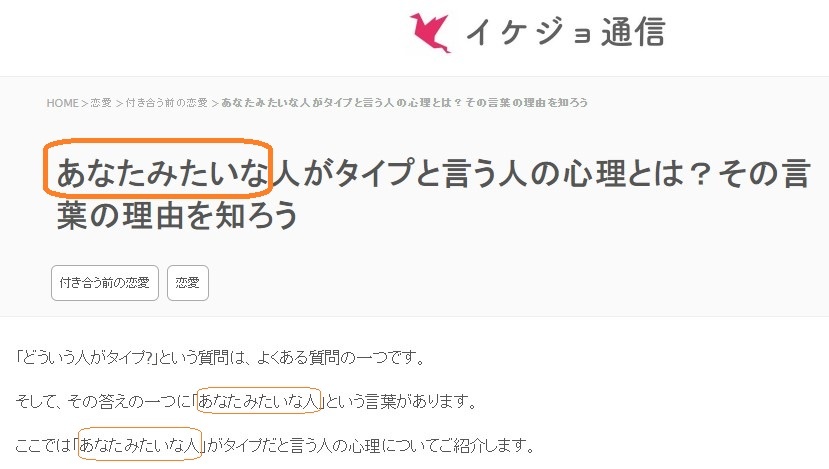みたい (mitai) Meaning Japanese Grammar - Like
Sandro Maglione
Get in touch with meみたい (mitai) is a な adjective meaning seems, similar to, resembles. みたい is one of several ways in Japanese to indicate that something is like or is similar to something else.
みたい is a colloquial way of expressing a similarity between two objects or entities.
In this post we learn more about the meaning of みたい, how it is formed, and when みたい is used through real example sentences.
How みたい is formed
Since みたい is a な adjective it is possible to use it like any other adjective of this category.
In fact みたい can follow verbs, adjectives and nouns:
- When みたい is placed at the end of the sentence you need to add だ (or です)
- When みたい is applied to a noun you have to add な, while in other cases, when みたい is not at the end of the sentence, you have to add the particle に
彼の鼻はバナナみたいに長い。
His nose length looks like a banana.
みたい comes from the verb 見る, which means to see.
兄は侍みたいな人だ。
My older brother looks like a samurai.
みたい is used more often in colloquial situations, as it is much less formal than ようだ.
もう売り切れのようだ。
It looks like it's already sold-out.
彼女は太陽みたいな人だ。
She is a (beautiful) person like the sun.
How and when to use みたい
The main use of みたい is to indicate a similarity, something that is similar to something else.
彼は子供みたいに笑う。
He laughs like a child.
In this example his way of laughing (笑う) is compared to that of a child (子供) using みたい: it seems like..., it looks like that of....
みたい is used when what is said is based on direct and reliable information.
壁は紙みたいに薄い。
The wall is thin like paper.
Sometimes in colloquial situations it is possible to omit だ (です) at the end of the sentence.
お人形さんみたい。
It looks like a doll.
みたい: just as if
Another use of みたい is to indicate a situation or experience that is just like something else. Also in this case we want to express the concept of similitude, something that seems like something else.
ジェットコースターに乗っているみたいだった。
It felt just like a roller coaster ride.
みたい: something like
In colloquial situations みたい can be used to mean something like, something similar to.
アルミ
どうすればいいの?
What would you like to do?
ルケ
漫画みたいなものはどう?
How about something like manga?
Someone like you
Let's start from the title.

あなたみたいな人がタイプと言う人の心理とは?その言葉の理由を知ろう。
What is the psychology of people who say that people like you are their type? Let's find out why they say that.
Noun + みたいな as Adjective + Noun The following sentences:
「どういう人がタイプ?」という質問は、よくある質問の一つです。
'What kind of person is your type?' is one of the most frequently asked questions.
そして、その答えの一つに「あなたみたいな人」という言葉があります。
And one of the answers is: Someone like you.
Litterally: One of the answers is the expression: "Someone like you".
ここでは「あなたみたいな人」がタイプだと言う人の心理についてご紹介します。
Here, I will introduce the psychology of people who say that Someone like You is their type.
The expression ご紹介します belongs to the Keigo, the Honorific Language. The strucures formed by Noun + する use the honorific prefixes ご or お before the Noun.
- ご連絡します: I will contact you
- お電話します: I will call you
Like a Japanese

外国人としてどうやって日本人みたいに日本語を話せるようになりますか?
As a foreigner, how can I learn to speak Japanese like a Japanese?
In this sentence we find みたい used as an adverb, followed by the particle に. Noun + みたいに + Verb
イギリス人のように英語をしゃべる。
Speak English like a British person.
Examples of みたい
誰もいないみたいだ。
It seems that nobody is there.
夢みたいな話だ。
A story that seems like a dream.
お茶みたいなものない?
Do you have something like tea?
Similar grammar points in Japanese 📚
~ていく
~ていく (teiku) Meaning Japanese Grammar - Keep Doing
てよかった
てよかった (te yokatta) Meaning Japanese Grammar - I'm Glad That...
それでもいい
それでもいい (soredemoii) Meaning Japanese Grammar - It's Fine
それでも
それでも (sore demo) Meaning Japanese Grammar - Still
させられる・せられる
させられる・せられる (saserareru serareru) Meaning Japanese Grammar - To Be Made To Do Something
ないで
ないで (naide) Meaning Japanese Grammar - Without Doing

